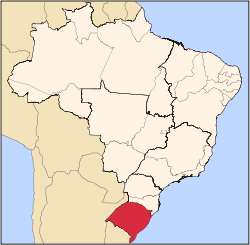Roque Gonzales, Rio Grande do Sul
Roque Gonzales is a municipality located in the northwestern region of the southernmost state of Rio Grande do Sul, Brazil, not very far from Argentina which is located to the west, across the Uruguay River. Roque Gonzales was named after the jesuit missionary and saint Roque González de Santa Cruz.
The municipality would be partially flooded by the proposed Garabí Dam.[1]
Neighboring municipalities
- Porto Xavier
- São Paulo das Missões
- São Pedro do Butiá
- Rolador
- São Luiz Gonzaga
- Dezesseis de Novembro
- Pirapó
History
Primarily German-Brazilians or Deutschbrasilianer from the old colonized areas of the state of Rio Grande do Sul settled Roque Gonzales. The original German settlements whence they came were often referred to as Altkolonie because they are located on the eastern part of the state where Germans first put down roots, starting in 1824 (i.e. Estrela, Montenegro, Lajeado, etc.).
Pommersch or the Pomeranian language has been spoken in Esquina Emanuel since the early days of its foundation because it was settled by immigrants of Pomeranian descent. Dona Otília was settled primarily by Lutherans. Typically most of the German speakers in the municipality and in the wider region spoke Riograndenser Hunsrückisch and identified with the Roman Catholic tradition and customs. In 2012 the state chamber of deputies voted unanimously in favor of recognizing this Germanic dialect an official historical culture good to be preserved.
The city of Roque Gonzales is home of writer Nelson Hoffmann who wrote, among other works, Eu vivo só ternuras which was translated into Italian as Io vivo di tenerezze by Marco Scalabrino. The book is about the relationship of a grandfather, the author, with his first grandson. It has received positive reviews and has been classified by some as a book for all ages.
The Premio Missões of literature of Roque Gonzales is headed by João Weber Griebeler of Igaçaba Produções Culturais and it covers mostly Brazilian literature but some works in other languages are also occasionally published (collective anthology). Griebeler also is the editor of the local newspaper, the Jornal Igaçaba.
Roque Gonzales is located near the margins of the Rio Ijuí. Not too far south from the town the river turns into a wide waterfall: Salto Pirapó. Camping is available in the area. It is a great place for bird watching, hiking a relaxation. This is also the location of a small hydroelectric plant built almost one hundred years ago and a fixture in local history. Two new hydroelectric plants have been built on the Ijuí river within the general region.[2][3]
See also
References
- ↑ Eletrobras apresenta Garabi-Panambi a prefeitos (in Portuguese), Eletrobras CGTEE, 7 April 2014, retrieved 2016-11-11
- ↑ "Usina Hidrelétrica Passo São João de Roque Gonzales começa a operar | clicRBS Noroeste Missões". Wp.clicrbs.com.br. 2011-08-24. Retrieved 2016-09-18.
- ↑
External links
- Roque Gonzales official site (in Portuguese)
- Roque Gonzales – Cerro Inhacurutum (in Portuguese)
Coordinates: 28°07′S 55°02′W / 28.117°S 55.033°W
